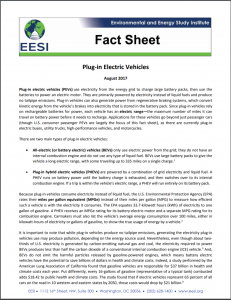Full Title: Plug-in Electric Vehicles: Fact Sheet
Author(s): EESI
Publisher(s): Environmental and Energy Study Institute
Publication Date: August 1, 2017
Full Text: Download Resource
Description (excerpt):
Plug-in electric vehicles (PEVs) use electricity from the energy grid to charge large battery packs, then use the
batteries to power an electric motor. They are primarily powered by electricity instead of liquid fuels and produce
no tailpipe emissions. Plug-in vehicles can also generate power from regenerative braking systems, which convert
kinetic energy from the vehicle’s brakes into electricity that is stored in the battery pack. Since plug-in vehicles rely
on rechargeable batteries for power, each vehicle has an electric range—the maximum number of miles it can
travel on battery power before it needs to recharge. Applications for these vehicles go beyond just passenger cars
(though U.S. consumer passenger PEVs are largely the focus of this fact sheet), as there are currently plug-in
electric buses, utility trucks, high-performance vehicles, and motorcycles.
